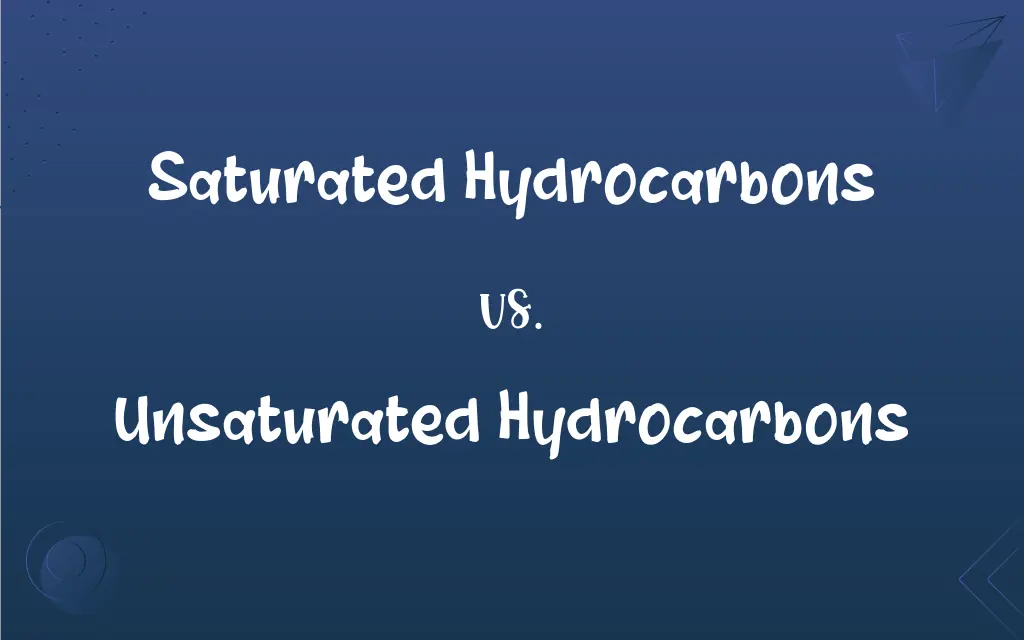Saturated Hydrocarbons vs. Unsaturated Hydrocarbons: What's the Difference?
Edited by Aimie Carlson || By Harlon Moss || Updated on October 20, 2023
Saturated hydrocarbons contain only single bonds between carbon atoms, while unsaturated hydrocarbons have one or more double or triple bonds.

Key Differences
Saturated hydrocarbons and unsaturated hydrocarbons differ primarily in their chemical structure and properties. Saturated hydrocarbons have all the hydrogen atoms they can possibly hold, which means there are only single bonds between the carbon atoms. Unsaturated hydrocarbons, conversely, contain one or more double or triple bonds between carbon atoms, implying a deficiency in hydrogen.
In saturated hydrocarbons, each carbon atom forms four single covalent bonds with other atoms. This characteristic makes them relatively stable. Unsaturated hydrocarbons, on the other hand, contain carbon atoms connected by double or triple bonds, making them more reactive. The presence of these multiple bonds allows unsaturated hydrocarbons to participate in various chemical reactions.
Saturated hydrocarbons are typically found in solid fats and are less healthy for consumption. They have a higher melting point due to the strong Van der Waals forces between the molecules. Unsaturated hydrocarbons, in contrast, are typically liquid at room temperature, like vegetable oils, and are considered healthier.
The sources of saturated hydrocarbons are often animal fats and certain plant oils. These hydrocarbons are not as susceptible to oxidation, making them less likely to become rancid. Unsaturated hydrocarbons, being more reactive, are more prone to oxidation and can become rancid if not stored properly.
Comparison Chart
Type of Bonds
Only single bonds
Double or triple bonds
ADVERTISEMENT
Reactivity
Less reactive
More reactive
Physical State at Room Temperature
Typically solid (fats)
Typically liquid (oils)
Health Implications
Generally considered less healthy
Generally considered healthier
Susceptibility to Oxidation
Less susceptible
More susceptible
Saturated Hydrocarbons and Unsaturated Hydrocarbons Definitions
Saturated Hydrocarbons
Found in animal fats and certain tropical oils.
Many processed foods are high in saturated hydrocarbons due to the use of tropical oils.
ADVERTISEMENT
Unsaturated Hydrocarbons
Not fully saturated with hydrogen atoms due to multiple bonds.
The presence of double bonds in unsaturated hydrocarbons allows for the addition of atoms.
Saturated Hydrocarbons
Typically less reactive than their unsaturated counterparts.
The chemical stability of saturated hydrocarbons makes them ideal for long-term storage.
Unsaturated Hydrocarbons
Can undergo addition reactions because of the presence of multiple bonds.
Polymer industries often use unsaturated hydrocarbons as their starting material.
Saturated Hydrocarbons
Hydrocarbons that do not have multiple bonds.
Paraffin wax is a good example of a material rich in saturated hydrocarbons.
Unsaturated Hydrocarbons
Commonly found in vegetable oils and fish oils.
Diets high in unsaturated hydrocarbons are often recommended for heart health.
Saturated Hydrocarbons
Hydrocarbons with only single covalent bonds.
Margarine contains saturated hydrocarbons which makes it solid at room temperature.
Unsaturated Hydrocarbons
Hydrocarbons with one or more double or triple bonds.
Olive oil contains unsaturated hydrocarbons, which is why it remains liquid at room temperature.
Saturated Hydrocarbons
Compounds with the maximum number of hydrogen atoms.
The combustion of saturated hydrocarbons usually produces a clean flame.
Unsaturated Hydrocarbons
More chemically reactive than saturated hydrocarbons.
Unsaturated hydrocarbons are often used in chemical synthesis due to their reactivity.
FAQs
Are all saturated hydrocarbons safe for consumption?
Not necessarily. While many are in edible fats, some can be harmful in excessive amounts.
Are alkenes and alkynes unsaturated hydrocarbons?
Yes, alkenes have double bonds and alkynes have triple bonds, making them unsaturated.
Why are unsaturated hydrocarbons considered healthier?
They are often associated with beneficial health effects, like reducing bad cholesterol.
Can unsaturated hydrocarbons become saturated?
Yes, through hydrogenation. This process adds hydrogen, converting double bonds to single bonds.
Are saturated hydrocarbons solid at room temperature?
Typically, yes. For instance, animal fats are saturated and solid at room temperature.
Are saturated hydrocarbons more or less stable than unsaturated hydrocarbons?
Saturated hydrocarbons are generally more stable due to the absence of multiple bonds.
What happens when unsaturated hydrocarbons are hydrogenated?
They become saturated, turning double or triple bonds into single bonds.
What causes the reactivity of unsaturated hydrocarbons?
The presence of double or triple bonds makes unsaturated hydrocarbons more reactive.
Can saturated hydrocarbons undergo addition reactions?
No, they can't. Only unsaturated hydrocarbons can undergo addition reactions due to their double or triple bonds.
Which type of hydrocarbon is more prone to rancidity?
Unsaturated hydrocarbons are more prone to oxidation and can become rancid.
Can unsaturated hydrocarbons polymerize?
Yes, many can polymerize, especially in the presence of catalysts.
What's the primary source of saturated hydrocarbons in our diet?
Animal fats and certain tropical oils are primary sources.
Are saturated hydrocarbons more or less flammable than unsaturated ones?
Flammability can vary, but generally, both can be flammable under the right conditions.
Can unsaturated hydrocarbons be found in nature?
Yes, many vegetable oils and fish oils are rich in unsaturated hydrocarbons.
Why do saturated hydrocarbons have a higher melting point?
Stronger Van der Waals forces in saturated hydrocarbons lead to a higher melting point.
Do unsaturated hydrocarbons have a distinct smell?
Some do, but it varies based on the specific compound and its purity.
Which hydrocarbon is more abundant in nature, saturated or unsaturated?
Both are abundant, but their distribution varies based on the source.
How can I differentiate between saturated and unsaturated hydrocarbons by their structure?
Saturated hydrocarbons have only single bonds, while unsaturated ones have double or triple bonds.
Are saturated hydrocarbons found in petroleum?
Yes, petroleum contains a mix of both saturated and unsaturated hydrocarbons.
Are all unsaturated hydrocarbons liquid at room temperature?
Not all, but many are, especially those with shorter carbon chains.
About Author
Written by
Harlon MossHarlon is a seasoned quality moderator and accomplished content writer for Difference Wiki. An alumnus of the prestigious University of California, he earned his degree in Computer Science. Leveraging his academic background, Harlon brings a meticulous and informed perspective to his work, ensuring content accuracy and excellence.
Edited by
Aimie CarlsonAimie Carlson, holding a master's degree in English literature, is a fervent English language enthusiast. She lends her writing talents to Difference Wiki, a prominent website that specializes in comparisons, offering readers insightful analyses that both captivate and inform.































































